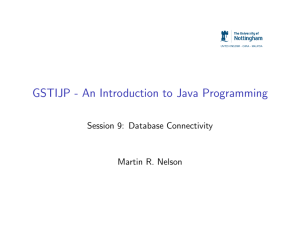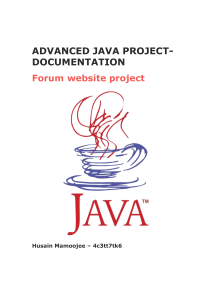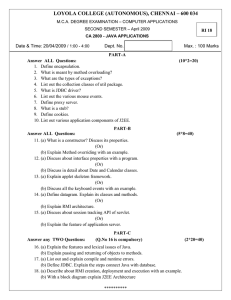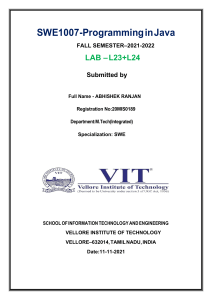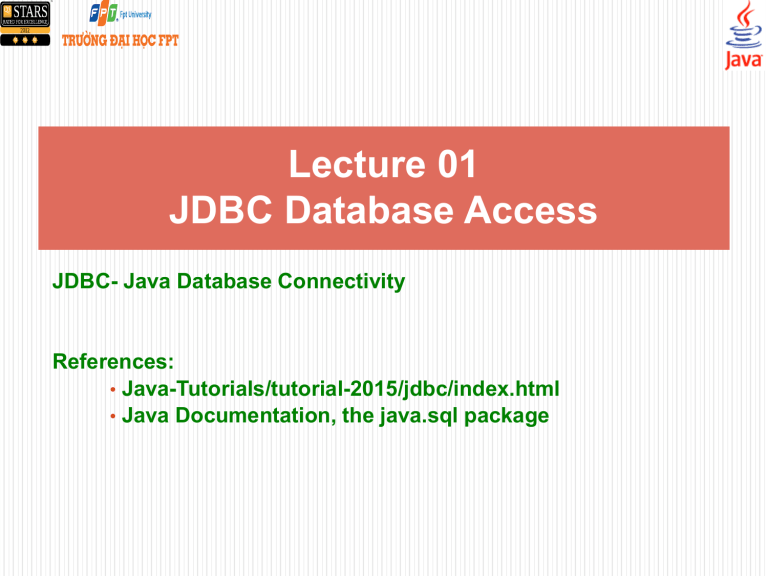
Lecture 01 JDBC Database Access JDBC- Java Database Connectivity References: • Java-Tutorials/tutorial-2015/jdbc/index.html • Java Documentation, the java.sql package Why should you study this lecture? In almost all large applications. Data are organized and stored in databases which are managed by database management systems (DBMS) such as MS Access, MS SQL Server, Oracle, My SQL,… Do you want to create Java applications which can connect to DBMSs? Database programming is a skill which can not be missed for programmers. Objectives Introduction to databases Relational Database Overview JDBC and JDBC Drivers Steps to develop a JDBC application. Test connection in Netbeans. Contents 1- Database and DBMS 2- Relational Database Overview 3- JDBC and JDBC Drivers 4- Steps to develop a JDBC Application 5- A Demonstration 1- Database and DBMS Database is a collection of related data which are stored in secondary mass storage and are used by some processes concurrently. Databases are organized in some ways in order to reduce redundancies. DBMS: Database management system is a software which manages some databases. It supports ways to users/processes for creating, updating, manipulating on databases and security mechanisms are supported also. DBMS libraries (C/C++ codes are usually used) support APIs for user programs to manipulate databases. 2- Relational Database Overview Common databases are designed and implemented based on relational algebra (set theory). Relational database is one that presents information in tables with rows and columns. A table is referred to as a relation in the sense that it is a collection of objects of the same type (rows). A Relational Database Management System (RDBMS)- such as MS Access, MS SQL Server, Oracle- handles the way data is stored, maintained, and retrieved. RDBMS: Structure Query Language (SQL) Data Definition Language (DDL): CREATE…/ ALTER…/ DROP… 3 languages: Data Manipulating Language (DML): SELECT…/ INSERT INTO … / UPDATE … / DELETE Data Control Language (DCL): GRANT…/ REVOKE … / DENY… RDBMS: SQL… Common DML queries: SELECT columns FROM tables WHERE condition UPDATE table SET column=value,… Where condition DELETE FROM table WHERE condition INSERT INTO table Values ( val1, val2,…) INSERT INTO table (col1, col2,…) Values ( val1, val2,…) 3-JDBC and JDBC Driver The JDBC™ API was designed to keep simple things simple. This means that the JDBC makes everyday database tasks easy. This trail walks you through examples of using JDBC to execute common SQL statements, and perform other objectives common to database applications. The JDBC API is a Java API that can access any kind of tabular data, especially data stored in a Relational Database. JDBC and JDBC Driver… JDBC APIs has 02 parts in the java.sql package. Part Details Purposes JDBC Driver DriverManager class Java.lang.Class.forName(DriverClass) will dynamically load the concrete driver class, provided by a specific provider for a specific database. This class implemented methods declared in JDBC interfaces. The class DriverManager will get a connection to database based on the specific driver class loaded. JDBC API Interfaces: Connection, Statement ResultSet DatabaseMetadata ResultSetMetadata Classes SQLException For creating a connection to a DBMS For executing SQL statements For storing result data set and achieving columns For getting database metadata For getting resultset metadata Refer to the java.sql package for more details in Java documentation JDBC and JDBC Driver… Java App. Connection con Statement stmt DriverManager executeQuery() getConnection() ResultSet rs createStatement() Process rs Specific JDBC Driver implement interfaces (loaded dynamically by java.lang.Class) Database Model of a JDBC App. Type 4-Driver: Native Protocol Communicates directly with the database using Java sockets Improves the performance as translation is not required Converts JDBC queries into native calls used by the particular RDBMS The driver library is required when it is used and attached with the deployed application (sqlserver 2000: mssqlserver.jar, msutil.jar, msbase.jar; sqlserver 2005: sqljdbc.jar; jtds: jtds.jar …) Independent platform Application Java Application Type IV JDBC Driver SQL command Result Set use Proprietary protocol Database Download Type 4 SQL Server JDBC Google : Microsoft SQL Server JDBC Driver MS SQL Server 2008 MS SQL Server 2005 Setup Configure Ports, Protocols for SQL Server Enable Server protocols and port Right click Attention: Disable VIA Enable client protocols and port Configure Ports, Protocols for SQL Server… Stop then restart SQL Server and SQL Server Agent for settings are affected. Right click Test connection in Netbeans Test connection in Netbeans Test connection in Netbeans Test connection in Netbeans 4-Steps to Develop a JDBC Application Step Description Use ( java.sql package) Methods 1 Load JDBC Driver Java.lang.Class forName(…) 2 Establish a DB connection java.sql.Connection java.sql.DriverManager 3 Create & execute SQL statements java.sql.Statement java.sql.PrepareStatement java.sql.CallableStatement execute(…) executeQuery(…) SELECT executeUpdate(…) INSERT/UPDATE/DELETE 4 Process the results java.sql.ResultSet first(), last(), next(), previous() getXXX(..) 5 Close ResultSet, Statement, Connection close() DriverManager getConnection(…) Connection Step 1,2 : Make connection 22/40 Step 3: Create &Execute a SQL statement String sql1 = “SELECT columns FROM table1, table2, … WHERE condition”; String sql2 = “UPDATE table SET column = value, … WHERE condition”; String sql3 = “INSERT INTO table VALUES ( val1, val2, … )” ; String sql4 = “INSERT INTO table (col1, col2, col3) VALUES ( val1, val2, val3)” ; String sql5 = “UPDATE table SET col1 = ?, col2=? WHERE condition”; // Connection con was created Statement stmt= con.createStatement(); ResultSet rs= stmt.executeQuery(sql1); int numOfInfectedRows = stmt.executeUpdate(sql2); int numOfInfectedRows = stmt.executeUpdate(sql3); int numOfInfectedRows = stmt.executeUpdate(sql4); PreparedStatement pStmt = con.preparedStatement(sql5); pStmt.setXXX (index, val); // from 1 int numOfInfectedRows = pStmt.executeUpdate(); // no argument Step 4: Process the results BOF Record 1 Move the current row: boolean next(), previous(), first(), last() Default: Result set moves forward only. Record 2 Record 3 ….. Get data in columns of the current row: TYPE getTYPE ( int columnIndex) // begin from 1 TYPE getTYPE ( String columnLabel) ….. ….. EOF SELECT desc AS description FROM T_employee Column name: desc Column Label: description ResultSet At a time, resultset maintains a current position. When the resultset is initialized, the position is the BOF position. An exception is thrown when the current position is out of its scope. Step 5: Close the connection Opening Order: Connection Statement ResultSet Closing Order: ResultSet Statement Connection Attention!!! At a time, a connection can be bound with ONLY ONE result set. An exception will be thrown if we try binding a connection with another result set. EX: String sql1 =“SELECT…”; String sql2 =“SELECT…”; ResultSet rs1= stmt.executeQuery(sql1); ResultSet rs2= stmt.executeQuery(sql2); EXCEPTION You should close the rs1 before trying get the rs2 result set Solution: Transfer data in the rs1 to ArrayList (or Vector) then close rs1 before get new data to rs2. Thank You
